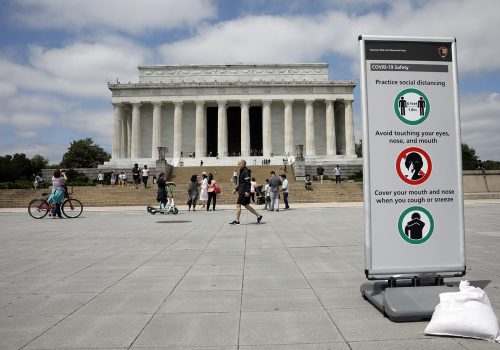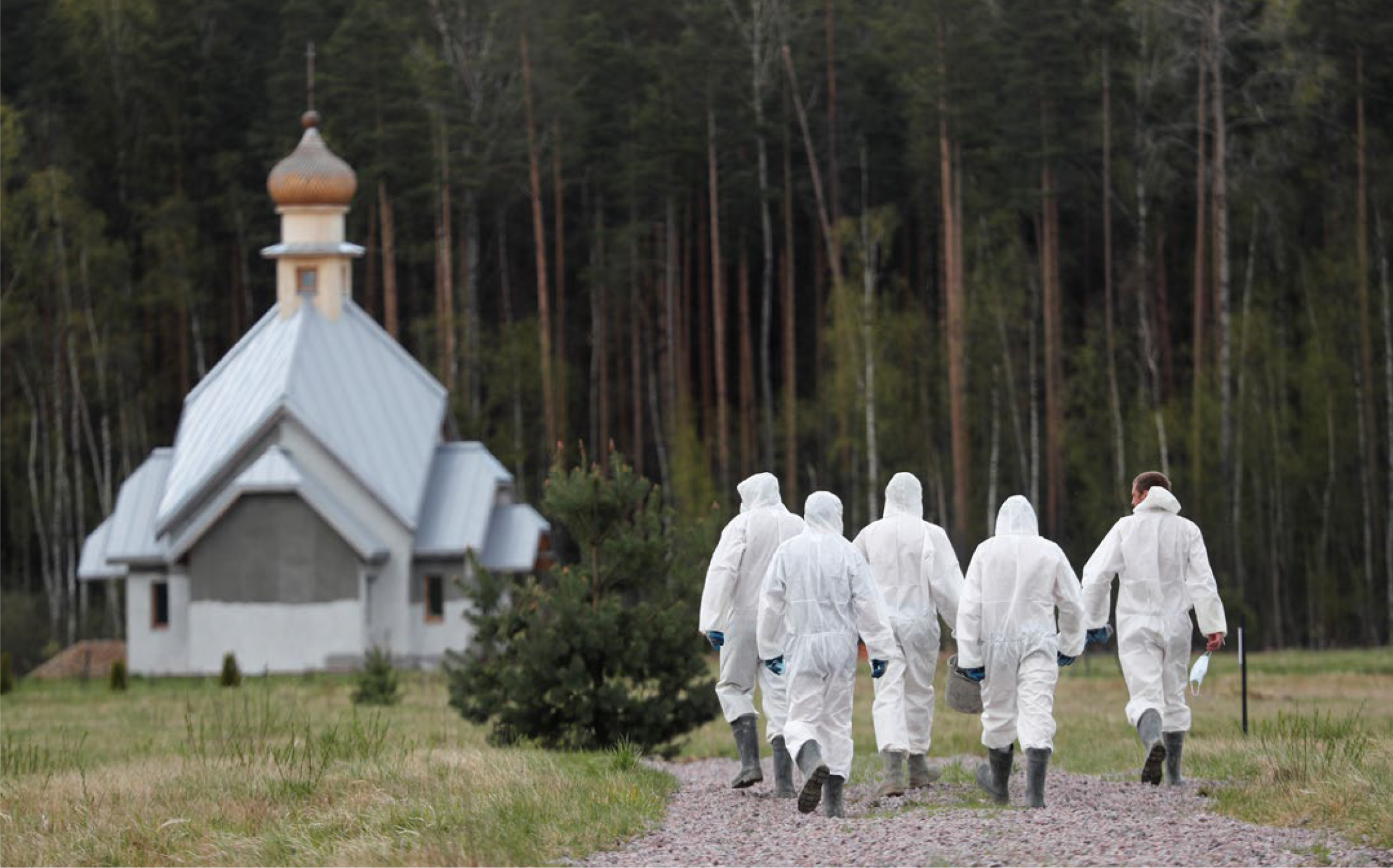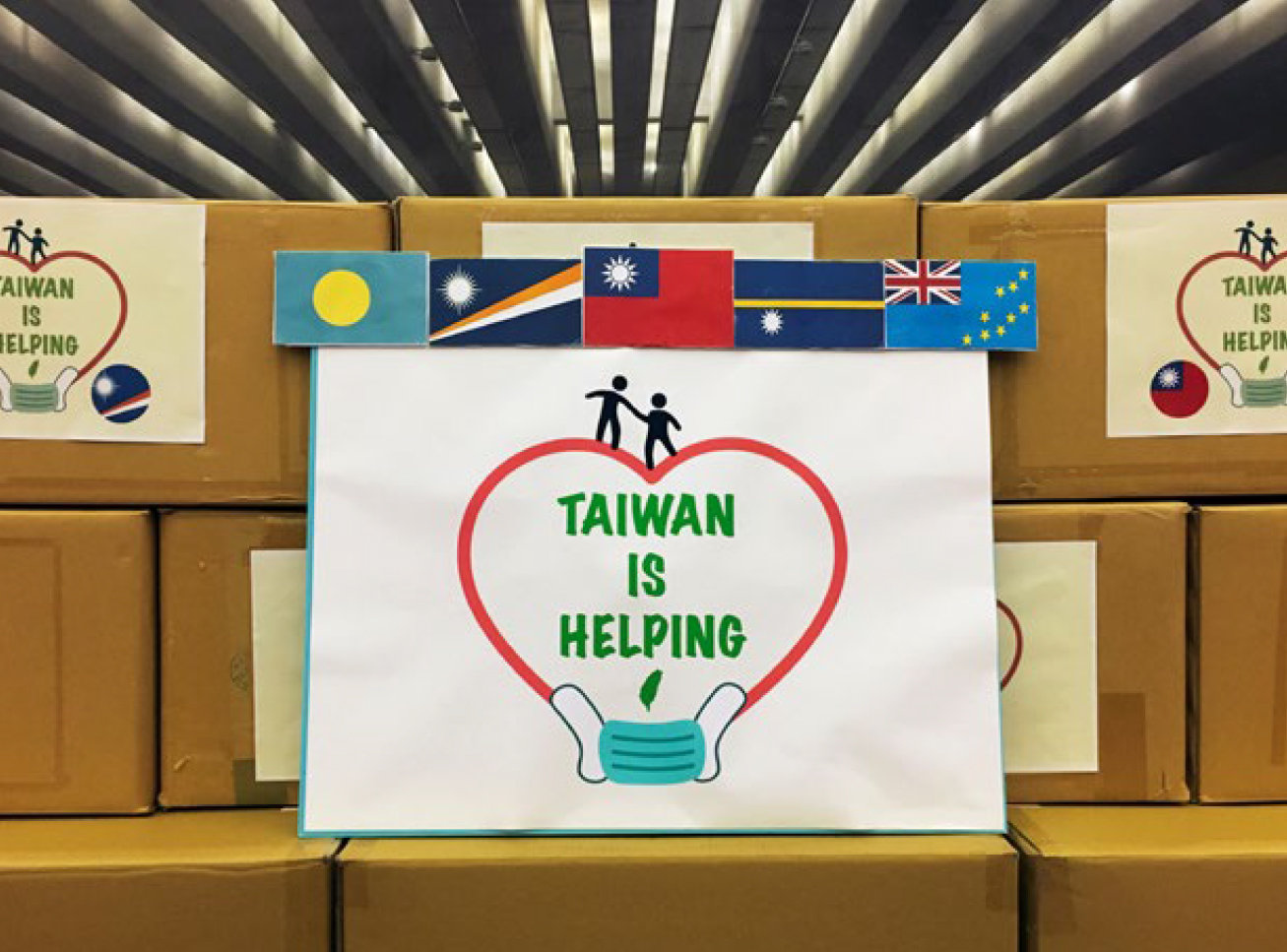Taking stock: Where are geopolitics headed in the COVID-19 era?
By Jeffrey Cimmino, Matthew Kroenig, and Barry Pavel
The COVID-19 pandemic is a strategic shock, and its almost immediate, damaging effects on the global economy constitute a secondary disruption to global order. Additional secondary strategic shocks (e.g., in the developing world) are looming. Together, these developments pose arguably the greatest threat to the global order since World War II. In the aftermath of that conflict, the United States and its allies established a rules-based international system that has guaranteed freedom, peace, and prosperity for decades. If the United States and its allies do not act effectively, the pandemic could upend this order.
 Post-Covid-19
Post-Covid-19
This issue brief considers the current state of the pandemic and how it has strained the global rules-based order over the past few months. First, it considers the origins of the novel coronavirus and how it spread around the world. Next, it examines how COVID-19 has exacerbated or created pressure points in the global order, highlights uncertainties ahead, and provides recommendations to the United States and its partners for shaping the post-COVID-19 world.
Strategic shock: What is COVID-19?
On December 27, 2019, health officials in Wuhan, China, learned that a novel coronavirus was responsible for a mysterious respiratory illness that proved resistant to anti-flu drugs and which had been observed in patients several weeks prior. Over the next few weeks, Chinese officials attempted to cover up the outbreak, reprimanding doctors for publicly discussing the new virus, ordering samples of the virus destroyed, and denying it could be spread from human to human. By January 13, the virus had spread beyond China, and soon after arrived in the United States. Chinese officials eventually implemented lockdowns, but not before around five million people had left the city of Wuhan unscreened.
COVID-19 is a disease caused by the novel coronavirus, part of a family of viruses known to cause respiratory infections in humans. Other well-known coronavirus-induced diseases include severe acute respiratory syndrome (SARS), which infected thousands in China and elsewhere from 2002-03, and Middle East respiratory syndrome (MERS). Like SARS, COVID-19 originated in China, in this case most likely at an animal market in Wuhan.
At the time of writing, the COVID-19 pandemic had infected more than 4.2 million individuals worldwide, although the number of infected is almost certainly higher as testing has been limited in most countries, including the United States. Around 1.3 million cases of COVID-19 have been confirmed in the United States, with New York and New Jersey affected the worst. The virus’s estimated mortality rate is 1 percent, with older individuals, as well as those with preexisting conditions, at a greater risk of death. At the time of writing, there were more than 280,000 global deaths, including around 80,000 in the United States.
The pandemic is unlikely to end anytime soon, even as at least 70 different vaccines are in development around the world. It could take more than a year before a vaccine and other treatments are ready for distribution. In the meantime, many countries have enacted measures to require social distancing in order to slow the virus’s spread and prevent health care systems from being overwhelmed. A March study by researchers at Imperial College London warned that the time when the measures are implemented, as well as strict enforcement, are critical for effective social distancing.
Countries such as Italy and Spain have seen their health care systems overrun by COVID-19 patients. In the United States, while the initial response to the virus was slow, social distancing measures appear to have slowed the spread of the virus in some parts of the country, although new hotspots continue to emerge.
Pressure points: How COVID-19 has affected the global order
At the onset of the COVID-19 pandemic, many analysts suspected that the crisis would alter the global order. After all, we have seen throughout history that plagues have contributed to the rise and fall of great powers. And, indeed, we are seeing that COVID-19 is already having important geopolitical consequences.
A Brief History of Plagues and Geopolitics
A brief consideration of history reveals pandemics have the capacity to shape the rise and fall of great powers. In the fifth century BCE, Athens was a vibrant commercial state and naval power, but it fell victim to a plague during the Peloponnesian War with its rival Sparta. Its population ravaged by disease, Athens was defeated by the Spartans and lost its position as the premier power in Greece.
Similarly, early modern Venice was a commercial center and naval power, a dominant force in the Mediterranean. The Italian Plague of 1629-31 decimated Venice, however, and Northern European states such as England and the Dutch Republic filled the gap left by the declining Venetian Republic. The word “quarantine” comes from the Venetian dialect’s word for “40 days.”
In the fourteenth century CE, the Black Death led to the collapse of the British feudal system, which helped lay the groundwork for the rise of the modern capitalist economic system. In the fifteenth and sixteenth centuries, the Aztec Empire was destroyed by smallpox, opening the door to European colonization in the Americas. More recently, the Spanish Flu of 1918 killed fifty million people, adding to the tens of millions who died during World War I.
As these examples illustrate, pandemics have the capacity to alter geopolitics and to accelerate already present trends. We are currently seeing such effects in many areas, most notably in the global economy.
Use the menu below to view Pressure Points and policy recommendations by category:
Policy Recommendations
Despite these uncertainties, there are some obvious next steps for US and allied policy. Most importantly, the United States and its allies and partners need to develop a comprehensive joint strategy to address COVID-19 and shape the post-pandemic global order. The United States and its allies should orient their strategy toward revitalizing and adapting the rules-based order in light of the weaknesses made plain by the pandemic.
Public Health: Reduce the Threat of Coronavirus and Bolster Global Public Health Resilience
The United States should lead a “Counter-Coronavirus Coalition” made up of allies and partners to implement strong joint measures to curb the virus’s spread, as well as unleash its economic might to produce materials (e.g., masks, ventilators) necessary to ensure those afflicted with the illness receive care. Abroad, the United States needs to resist temptations of nationalism and going-it-alone: the United States should work closely with its allies and partners, supporting them with medical resources and acting as a more reliable partner than China. The United States should act as the global leader in this crisis, stemming China’s efforts to seize the crisis as an opportunity to expand its influence abroad. Once the virus has been brought under control, the key factor in gauging global leadership will not have been who was responsible for the start of the pandemic, but who finished it. The United States’ vast resources, partnerships, and capacity for innovation puts it in a prime position to take up the mantle of leadership, produce medical supplies and vaccines, and quash the pandemic.
Moreover, while the United States should be tough on the WHO for its deference to China, it should also seek to strengthen global public health institutions, erect new ones where necessary, and reassert its influence in them. Whereas China has increased its influence in international organizations such as the WHO, the United States has retreated from multilateralism in recent years. The Chinese government, despite its culpability in allowing the virus to spiral into a pandemic, is also pushing for a new multilateral public health apparatus in the form of the Health Silk Road. The United States should not cede global leadership in refashioning and constructing multilateral institutions. In leading a global response to the pandemic, it should also lead the revitalization of international health institutions to ensure they have the capacity to address outbreaks, facilitate cooperation, and avoid the baser influences of authoritarian states. In the end, transparency is a major attribute in stemming fast-breaking global health crises, and democratic countries led by the United States, therefore, have an advantage over authoritarians who suppress and destroy important health data.
Economics: Facilitate a Global Economic Recovery
The virus will likely cause a global recession and possibly a depression. Protectionism will prove tempting, especially as populists in the West use the pandemic to attack globalism as fragile and dangerous. But this temptation should be rebuffed—protectionism failed to stem the Great Depression in the 1930s and only worsened an inward, nationalistic turn among global powers that fed into World War II. Instead, the United States and its partners should immediately work together to rebuild the global economy. China will look for Western divisions and lasting economic weakness as an opportunity to carve out a larger role for itself in the global order; however, resolute actions by the United States and its partners will both facilitate a quicker economic recovery and place them in a stronger position to approach China on shaping the post-pandemic global economy. The United States’ $2 trillion stimulus is a positive step in the direction of economic recovery, as are the recent steps taken by the EU. Furthermore, the Federal Reserve is working in conjunction with other nations’ central banks to ease the pressure on the global economy. Moreover, whereas China has limited experience with booms and busts due to an extended period of economic growth, the United States and its partners are used to market cycles, and this should give them added resilience to the current shock.
Diplomacy: Strengthen Alliances
The United States should reach out to its allies to strengthen coordination for a global response to the pandemic. When working together, the United States and its allies can amass an impressive degree of economic, diplomatic, and military clout, as well as scientific knowledge, all of which is integral to a comprehensive response to the pandemic. Where relationships have been frayed in previous months, the United States should work to repair them and be willing to take the lead of a coalition of states dedicated to countering the coronavirus. To revitalize the rules-based order requires determined US and allied leadership, and a willingness to forge new institutions to address the challenges of the post-pandemic world, as when the G20 was elevated in importance during the 2008 financial crisis.
National Security and Defense: Reorder National Security Priorities and Deter Chinese and Russian Aggression
The United States and its allies must lead the reordering of national security priorities in the post-pandemic era as well as demonstrate the resolve to defend the rules-based order against aggressive acts on the part of China and Russia. Western publics are rightly going to demand that the concept of national security be broadened to include security against pandemics. How this new concept is integrated into US national security as well as US alliances and security partnerships should be a top priority for planners during the rest of 2020. This must be done in a way that effectively balances pandemic prevention and mitigation with other national security threats and challenges.
Moreover, revisionist powers have already launched disinformation campaigns to muddy the origins of the virus and sow confusion in the West. The United States and its allies should take steps to ensure this disinformation is countered and that democratic systems of government can withstand its effects. While the United States’ and its allies’ military readiness has been weakened by the virus, they are still able to exercise a great degree of military power. High-level statements and shows of force can be used by US and allied forces to demonstrate their commitment to deterring and defeating aggression.
Conclusion
In just a few months, the COVID-19 pandemic has upended global health security, sent the world economy into a tailspin, and intensified great-power rivalry. Precisely how long it will take for governments to contain the virus and for scientists to develop effective therapies and a vaccine remains unclear. This analysis of the coronavirus’s impact on the global order has shown there are many geopolitical uncertainties that should be monitored in the coming months. The next paper in this series on shaping the post-pandemic world, an Atlantic Council Strategy Paper, will consider how these uncertainties might be resolved and what the world could look like in the coming months and years.
Related Experts: Barry Pavel, Matthew Kroenig, and Jeffrey Cimmino
Image: REUTERS/Kevin Lamarque
Oops...
It looks like we're having a technical issue.
If refreshing the page doesn't resolve the issue you could try clearing the sites browser cache.



